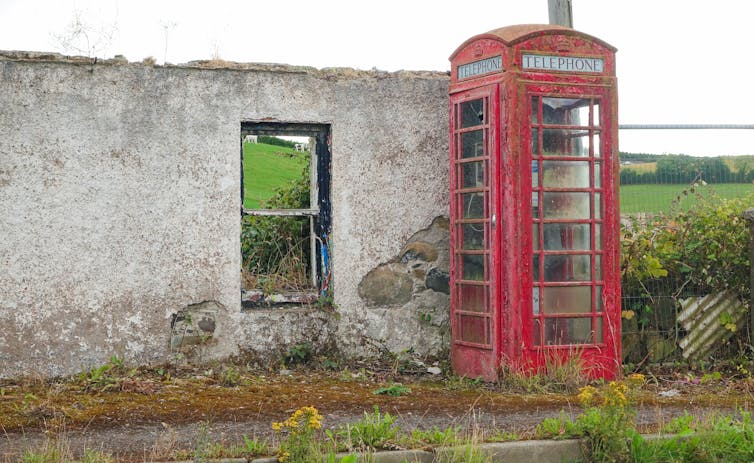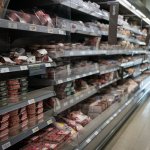mepstock/Shutterstock
In Britain, people imagine poverty as mainly an urban phenomenon. We think of poverty as rundown housing estates or tower blocks, far from the idyllic countryside scenes of shows like Escape to the Country.
But this is only part of the picture. Poverty in rural areas is more widespread than people might think. Fifty per cent of rural households experienced poverty at some point between 1991-2008 (54% in towns and cities). Surveys by the Financial Conduct Authority, an independent regulatory body, revealed that 54% of rural dwellers were financially vulnerable in 2018.
We have found that low pay, insecure employment, unaffordable housing and poor public transport infrastructure are all factors driving rural poverty. But the figures used to measure poverty (and determine where state support goes) are not always appropriate for rural contexts.
For example, the index of multiple deprivation, which governments use to identify areas where poverty is concentrated, can miss rural poverty, which is typically more dispersed. Such indices also use data on lack of car ownership to help measure an area’s poverty – but in a rural area, a car is essential even for poorer households.
Our new book Rural Poverty Today: Experiences of Social Exclusion in Rural Britain shows the reality of rural poverty in Britain, and how the current cost of living crisis is exacerbating it. And while families everywhere are suffering, those in rural areas have more difficulty accessing state support through the welfare system.
Rural cost of living
A 2021 report by Loughborough University found that for households in remote rural areas in Scotland, the minimum income standard is typically 15-30% higher than it is for urban households.
Rural living costs are higher largely because of fuel costs for heating and transport, and higher prices for food and other essentials. A 2020 study mapped “double energy vulnerability” – the combination of high fuel costs for transport and for heating – in Britain. The researchers found that rural households face the greatest financial pressure, as they pay a higher proportion of their income on these fuel costs. Rural homes tend to be older, larger, poorly insulated, difficult and costly to retrofit with insulation, and are often not on mains energy supplies.
In 2022, rural households had a higher fuel poverty rate (15.9%) and a larger fuel poverty gap (£956) than households in towns and cities. The fuel poverty rate was even higher (20.1%) for rural households off mains gas, who have to rely on expensive electricity or oil tanks instead.
Estimated fuel poverty rates for rural households in 2023 are higher still. Modelling by York University in early 2022 found that 57% of households in the Western Isles of Scotland (also called the Outer Hebrides) were experiencing fuel poverty, and they estimate that this has now risen to over 80%.
This has real human impacts. In our research, we found older people unable to put on the heating, people collecting firewood and only heating one room, and families unable to afford to refill their oil tanks (which have a minimum delivery of 500 litres) in midwinter. Urban households do not face this problem, as their houses are more commonly on mains energy.
The welfare state and rural poverty
Welfare – in the form of benefits and universal credit – should be a source of support for vulnerable households. But in our research, we’ve found that the welfare system is less able to support rural residents who may have unpredictable incomes, don’t have digital connectivity, or who do not have the skills to navigate a complex online system.
There is also a stigma attached to claiming benefits in small communities, where seeking welfare advice or claiming benefits is more visible and may lead to being perceived as lazy and not deserving of neighbours’ help.

chilterngreen.de/Shutterstock
Many of the challenges welfare claimants in rural areas face are similar to those in urban areas – the complexity and flawed design of the online system, payment delays and unpleasant experiences at assessment centres. But some issues are worse for rural claimants. We heard repeatedly of the inability of the benefits system (both legacy benefits and universal credit) to deal fairly with the volatility and irregularity of rural incomes from tourism, retail, or casual farm and estate work.
This can make household budgeting difficult, and in the most serious cases, increases the risk of debt and destitution. When benefits are overpaid, a frequent occurrence for people on irregular or volatile incomes who are unaware of the error, the overpayments are then deducted from subsequent months’ payments. This “clawback” can leave families with too little to live on.
À lire aussi :
What is it like to be destitute in Britain? ‘It makes you feel like some kind of underclass’
Distanced from support
Many people are unable to access the very systems which should help them receive support, particularly if they live far from welfare offices. Rural claimants with a long-term physical or mental illness or disability will face strenuous, lengthy journeys to attend work capability assessments, a requirement to receive disability benefits.
In the Western Isles, where there is no assessment centre, residents can wait up to a year before an officer visits the islands, unless they can travel to Inverness or Skye. And as the benefits system moves mostly online, those who don’t have or can’t afford broadband access will struggle to get the help they need.
Reaching and supporting the most vulnerable in rural communities is likely to become even more difficult as the cost of living crisis continues. Meeting the challenge should be front of mind for political parties as they compete for the rural vote in the next election.
![]()
Newcastle University received funding to support this research from Standard Life Foundation, a charity whose objective is to address financial hardship. Mark Shucksmith was principal investigator but received no personal financial benefit. Mark has previously conducted research on rural poverty funded similarly by external grants from Joseph Rowntree Foundation, Scottish Government, Scottish Consumer Council, Scottish Homes, Rural Development Commission, ESRC and EU.
Mark Shucksmith is a Trustee of Carnegie UK, Macaulay Development Trust and European Rural Communities Alliance.
In her research role at Scotland's Rural College, Jane Atterton received funding from Standard Life Foundation (now abdrn Financial Fairness Trust) to conduct the 'Rural Lives' research on rural financial hardship and social exclusion. Jane has undertaken research on a variety of topics relating to rural businesses and rural communities over the last 20 years with funding from a range of public, private and third sector organisations.
While employed as a Researcher at Scotland's Rural College, Jayne Glass received funding from Standard Life Foundation (now abdrn Financial Fairness Trust) to conduct the 'Rural Lives' research on rural financial hardship and social exclusion.











